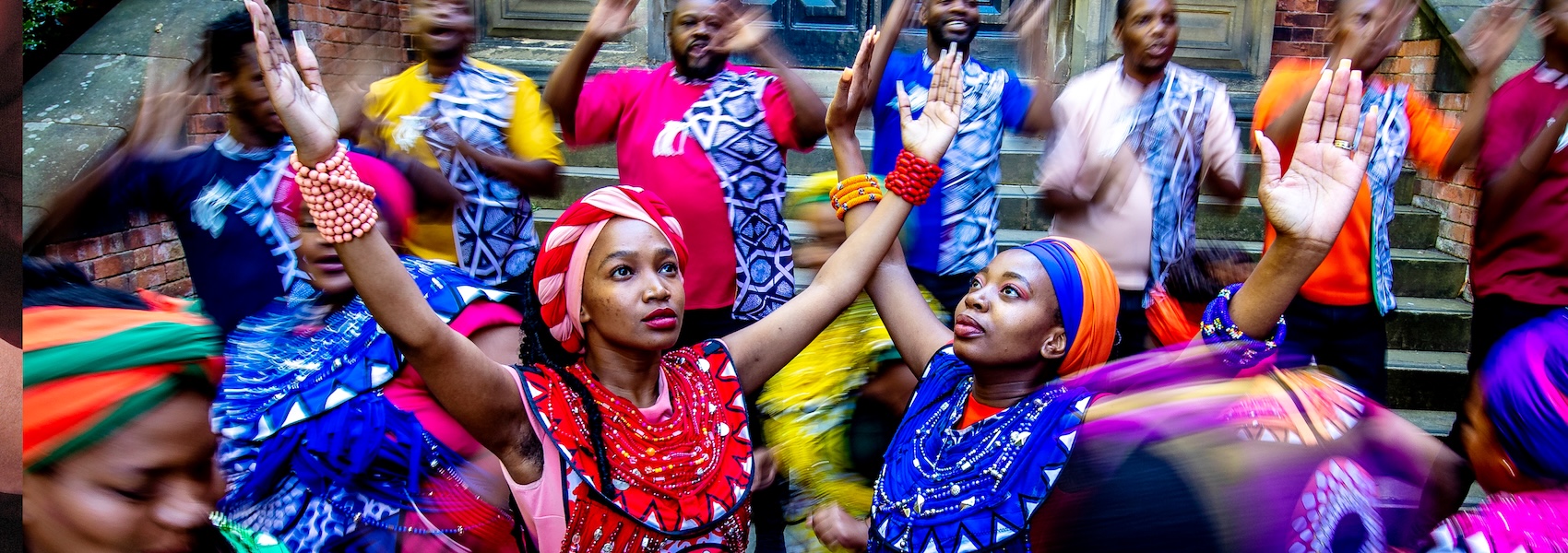Soweto Gospel Choir
- Thursday, November 20, 7:30 p.m.
- Frederick C. Tillis Performance Hall
Treat your students to an inspiring musical experience that bridges continents and shared histories through the soul-stirring harmonies of the Soweto Gospel Choir. Through a blend of African gospel, African American spirituals, reggae, and American popular music, this internationally renowned ensemble celebrates hope, unity, and resilience in the most difficult of times.
What Will My Students Experience?
Performance
This program is fifty minutes long and features an exciting blend of African gospel, African American spirituals, reggae, and American popular music.
Performers
The Soweto Gospel Choir is a musical ensemble from South Africa featuring a diverse group of more than thirty singers and musicians. Choir members often express their emotions through facial expressions, body language, and gestures, which help to connect with the audience on a deeper level.
Sound
The music is performed live on stage. The ensemble features instrumentalists who play various instruments such as keyboards, drums, and guitars, adding depth and richness to their performances.
What Will My Students Learn?
Regardless of what grade level you teach, there are many ways to use the Soweto Gospel Choir's performance to supplement and enhance what your students are already learning.
Here are few ideas to help you get started:
-
Invite social studies students to explore the history of apartheid in South Africa and the role of music in the liberation movement. Or, learn about the geography of South Africa, including its diverse cultures and how they influence the country's music.
-
Encourage history students to examine the connections between African American spirituals and South African gospel music, highlighting shared themes of resilience and hope.
-
Prompt English language arts students to analyze the lyrics of the choir's songs for themes, symbolism, and literary devices.
-
Inspire music students to study the musical elements of the choir's performances, such as harmony, rhythm, and instrumentation and to explore the concept of resistance through song.
-
Instruct visual arts students to create works inspired by the choir's performance. Works can reflect the emotions and themes conveyed through the music.
Please scroll down to the section titled “Educational Standards Alignment” for a list of relevant standards selected from state and national frameworks.
What Should I Know?
Origin of Soweto Gospel Choir
The Soweto Gospel Choir was formed in 2002 in Soweto, South Africa, by David Mulovhedzi and Beverly Bryer. Soweto, a township known for its significant role in the anti-apartheid movement, provides a poignant backdrop for the choir's origins. Deeply rooted in the struggle against apartheid, the choir's music reflects the resilience and spirit of the South African people. Their performances often include songs of freedom and hope, which resonate with the history of overcoming oppression. The choir's connection to apartheid is further highlighted by their dedication to Nelson Mandela and their participation in events that celebrate South Africa's journey to freedom. Through their powerful music, the Soweto Gospel Choir continues to honor the legacy of those who fought for equality and justice.
Nelson Mandela (1918-2013)
Nelson Mandela was a leader and a key figure in the fight against apartheid in South Africa. Born on July 18, 1918, he became a prominent anti-apartheid activist and was a member of the African National Congress (ANC). Mandela was imprisoned for twenty-seven years for his efforts to end apartheid. During that time, he became a global symbol of resistance and resilience.
After his release in 1990, Mandela played a crucial role in negotiating the end of apartheid and establishing multiracial elections in 1994. He became South Africa's first Black president and served from 1994 to 1999. Mandela's leadership and commitment to reconciliation and justice earned him international acclaim, including the Nobel Peace Prize in 1993.
Apartheid in South Africa
Apartheid in South Africa was a system of institutionalized racial segregation and discrimination enforced by the National Party government from 1948 to 1994. Soweto, an acronym for South Western Townships, became a significant symbol of resistance against apartheid. Originally established to house Black laborers working in Johannesburg, Soweto's residents faced harsh living conditions and limited access to basic services. The township gained international attention during the Soweto Uprising on June 16, 1976, when thousands of students protested the mandatory use of the Afrikaans language in schools. The brutal police response resulted in many deaths and injuries, highlighting the oppressive nature of apartheid and galvanizing global opposition to the regime. Soweto's history is deeply intertwined with the struggle for freedom and equality in South Africa, making it a powerful emblem of the anti-apartheid movement.
Gospel Music
Gospel music originated in the early twentieth century in the United States, with strong roots in African American communities in the South. It evolved from the spirituals sung by enslaved people, incorporating elements of blues and jazz. The genre gained popularity through church services and revivals, eventually influencing many other music styles.
African gospel music is a vibrant and diverse genre that blends traditional African musical elements with spiritual themes and messages. It is known for its energetic rhythms, powerful vocals, and a wide range of musical styles that reflect the rich cultural heritage of the African continent.
A Closer Look
Some of the songs performed by Soweto Gospel Choir are African American spirituals. A spiritual is a type of religious folk song most closely associated with the enslavement of African people in the American South. The African American spiritual constitutes one of the largest and most significant forms of American folk song today.
Spirituals are typically sung in a call and response form, where one person or group sings or plays a phrase (the "call"), and another person or group responds with a corresponding phrase (the "response").
Call-and-response songs played a crucial role in the lives of enslaved Americans, serving multiple purposes:
-
Work coordination: These songs helped synchronize group tasks, making physically demanding labor more manageable as the rhythmic nature kept everyone in sync.
-
Communication: Enslaved people used call-and-response songs to communicate over long distances. The call could convey messages or instructions, while the response ensured the message was received and understood.
-
Emotional expression and solidarity: These songs provided a way to express emotions, share experiences, and foster a sense of community. The interactive nature of call-and-response allowed individuals to feel connected and supported, even in harsh conditions.
-
Spiritual and religious significance: Many call-and-response songs were spirituals that conveyed religious messages and offered hope and solace. They were often sung during religious gatherings and served as a form of spiritual resistance against the oppression of slavery.
-
Coded messages: Some songs contained hidden messages that could help enslaved people plan escapes or communicate about safe routes and times for the Underground Railroad.
African American spirituals have significantly influenced various musical genres. They laid the foundation for gospel music, which shares similar themes of devotion and perseverance. The emotional depth and rhythmic patterns of spirituals also contributed to the development of blues, jazz, and soul music. These genres, in turn, have shaped modern music styles like rock, R&B, and hip-hop.
What To Listen For
Listen for the following elements of African gospel and African American spirituals during the performance.
Rhythms and Instruments:
-
Traditional instruments: Drums, shakers, xylophones, and other indigenous instruments
-
Modern instruments: Keyboards, guitars, and synthesizers
-
Spirituals feature complex rhythms and syncopation which reflect African musical traditions.
Vocal Styles:
-
Soulful and powerful vocals: Strong, emotive singing often with a lot of passion
-
Call-and-response patterns: Interaction between the lead singer and the choir or congregation
-
Harmonies: Rich and layered vocal harmonies
Cultural Elements:
-
The music often incorporates elements of African culture, including traditional melodies, languages, and stories. This fusion of cultural and religious elements makes African gospel choir music unique and deeply resonant.
Languages:
-
Multilingual: Songs are performed in various African languages, as well as in English and French.
Themes:
-
Spiritual messages: Focus on faith, hope, redemption, and praise
-
Cultural elements: Incorporation of local traditions and stories
-
Lyrics often use symbolism and metaphor to convey deeper meanings, such as freedom and liberation.
Think About It
Consider any iteration of the following questions to help deepen your students’ understanding of the Soweto Gospel Choir performance.
-
Watching a musical ensemble perform live (as opposed to listening to a recording) provides an additional layer of meaning to the performance.
> While on stage, how did the singers interact with one another? With the audience?
> How did their movements and gestures work with the music to convey the overall theme or emotion of the performance? -
Choral music can preserve and promote cultural heritage. Many choirs perform pieces from various traditions, helping to keep these cultural expressions alive and introducing them to new audiences.
> Are there songs (or other art forms such as dance) that help you feel connected to a specific culture or tradition?
> If so, how did you first learn about this art form? Do you plan to teach it to others? -
Some of the songs performed by the Soweto Gospel Choir utilize a call-and-response technique in which one person or group sings or plays a phrase (the "call"), and another person or group responds with a corresponding phrase (the "response").
> How does this technique foster a sense of community and togetherness among performers and listeners?
> The “response” is usually repetitive, creating a rhythmic and hypnotic effect. What effect does this have on the audience? -
Several of the songs you will hear the Soweto Gospel Choir perform are rooted in their fight against oppression and are relevant to those fighting oppression today.
> Is there a song (or lyrics from a song) performed by the choir that stood out to you on the theme of oppression or injustice?
> If so, did the song provide a solution to or guidance on how to deal with oppression and injustice?
> What song do you recommend the choir consider adding to their repertoire? Why?
Educational Standards Alignment
While the following list is not a complete list of applicable standards, it provides a set of relevant standards you can use to develop lessons in line with state and national standards and requirements.
Massachusetts 2018 Curriculum Framework for History and Social Science
World History II Content Standards Grades 9-12
Topic 5. The Cold War Era, 1945–1991 [WHII.T5]
6. Explain the defense of and resistance to the official South African government policy of apartheid (legalized racial segregation) between 1948 and 1991, and analyze how opposition by the African National Congress, including resistance leader Nelson Mandela, and international organizations such as the United Nations, contributed to the downfall of apartheid.
National Core Arts Standards
Music (PK-8) / Responding / MU:Re7.1
Anchor Standard: 7. Perceive and analyze artistic work.
3rd Grade
MU:Re7.2.3.a - Demonstrate and describe how a response to music can be informed by the structure, the use of the elements of music, and context (such as personal and social).
4th Grade
MU:Re7.2.4.a - Demonstrate and explain how responses to music are informed by the structure, the use of the elements of music, and context (such as social and cultural).
5th Grade
MU:Re7.2.5.a - Demonstrate and explain, citing evidence, how responses to music are informed by the structure, the use of the elements of music, and context (such as social, cultural, and historical).
6th Grade
MU:Re7.2.6.b - Identify the context of music from a variety of genres, cultures, and historical periods.
7th Grade
MU:Re7.2.7.b - Identify and compare the context of music from a variety of genres, cultures, and historical periods.
CASEL Competencies (Social and Emotional Learning)
Social Awareness (Recognizing strengths in others)
The ability to understand the perspectives of and empathize with others, including those from diverse backgrounds, cultures, and contexts. This includes the capacities to feel compassion for others; understand broader historical and social norms for behavior in different settings; and recognize family, school, and community resources and supports.






